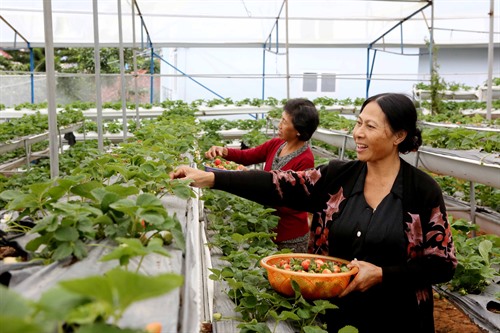 Society
Society

Việt Nam’s agriculture has achieved remarkable growth in recent years but needs reforms and policy shifts to overcome major economic and environmental challenges, according to a World Bank report made public yesterday.
 |
Strawberry harvesting in Đà Lạt City in the Central Highlands province of Lâm Đồng. Việt Nam’s agriculture has achieved remarkable growth in recent years, according to a World Bank report. — VNA/VNS Photo Phương Hoa |
HÀ NỘI — Việt Nam’s agriculture has achieved remarkable growth in recent years but needs reforms and policy shifts to overcome major economic and environmental challenges, according to a World Bank report made public yesterday.
The Việt Nam Development Report 2016, titled “Transforming Vietnamese Agriculture: Gaining more from less”, finds that over the past quarter century, Việt Nam’s agricultural sector has made enormous progress.
As a country once suffering from hunger, Việt Nam’s per capita food availability now ranks among the top tier of middle-income country.
“Việt Nam has over achieved its food security objectives,” said Steven Jaffee, Lead Rural Development Specialist at the World Bank and co-author of the report, at the event to present the findings.
The country’s average rice yields trail only behind those of China among Asia’s emerging economies, according to the report.
The country also ranks among the top five global exporters of products like shrimp, coffee, cashew, rice and pepper.
However, according to the report, performance in terms of efficiency, farmer welfare and product quality has been much less impressive.
The sector is experiencing a low quality of growth, as shown by low profits for smallholder farmers, considerable under-employment among agricultural workers, unreliable product quality and food safety, and limited technological or institutional innovation. Việt Nam also lags behind regional peers in terms of agricultural land, labour, and water productivity.
Most of the country’s agricultural trade is in the form of raw commodities, sold at lower prices than those of leading competitors, due to quality or other differences, the report says.
Although Việt Nam has emerged as a powerhouse in terms of commodity trade, “much of that trade is in sort of lower quality segment of the market,” Jaffee said.
He said the label-value of Vietnamese agricultural exports was low, adding that most consumers outside Việt Nam did not know they were consuming Việt Nam’s products.
“You can see Vietnamese restaurants everywhere but most people don’t know they are drinking Vietnamese coffee, eating Vietnamese shrimp. That invisibility means that a lot of money from your export is really earned abroad by those doing repackaging, branding under their own names,” he said.
Besides, the report finds that over-intensive use of inputs such as land and other natural resources, fertiliser and pesticides in production have resulted in an increasing environmental cost.
The environmental consequences of Việt Nam’s agricultural success have ranged from deforestation and fishery resource depletion, to a growing incidence of land degradation and water pollution, it says.
“The country’s agricultural output is exacting a price on the environment,” said World Bank Country Director for Việt Nam, Ousmane Dione. “‘Business as usual’ is no longer an option for the sector - growth has slowed, it is vulnerable to climate hazards and leaves a large environmental footprint.”
The report suggests it is time the country’s agricultural sector to “generate more from less”, which means generating economic value, as well as farmer and consumer welfare, using less natural and human capital. The sector will also need to increasingly compete on the basis of reliable supply, predictable quality and assured food safety.
The report suggests that Government needs to play an important role in facilitating a more active agricultural land market, the development of a market for mechanisation services and the revitalisation of the agricultural innovation system.
The Government will need to deploy an effective combination of regulations, incentives and facilitative services to stimulate and monitor a greener agriculture and a system for food safety and consumer protection.
The Government should also improve educational and vocational training services for farmers in order to accelerate the adoption of improved farm and post-harvest technologies, the report says.
Speaking at the event, Lương Văn Tự, Chairman of the Việt Nam Coffee and Cocoa Association, suggested that attention should also be paid to increasing multi-functional value of the agricultural section, such as values relating to environment, landscape, and tourism.
“Many coffee farms are earning money from providing tours to the farm, besides earning from production,” he said.
He also urged the Government to create a more favourable capital market for agricultural enterprises to invest in agro-product processing and support enterprises in seeking foreign markets for processed products, which are often highly protected and hard to access.
Senior economist Phạm Chi Lan recommended reforms in land policies to ensure that farmers and enterprises are guaranteed a long-term right of land usage.
“Only then do they feel secure to invest in farming and agricultural production,” she said.
She also pointed out that to make agricultural development a success, all policy should put farmers at the centre.
“Policy tools should be used to reduce farmers’ disadvantages and increase their benefits,” she said. — VNS